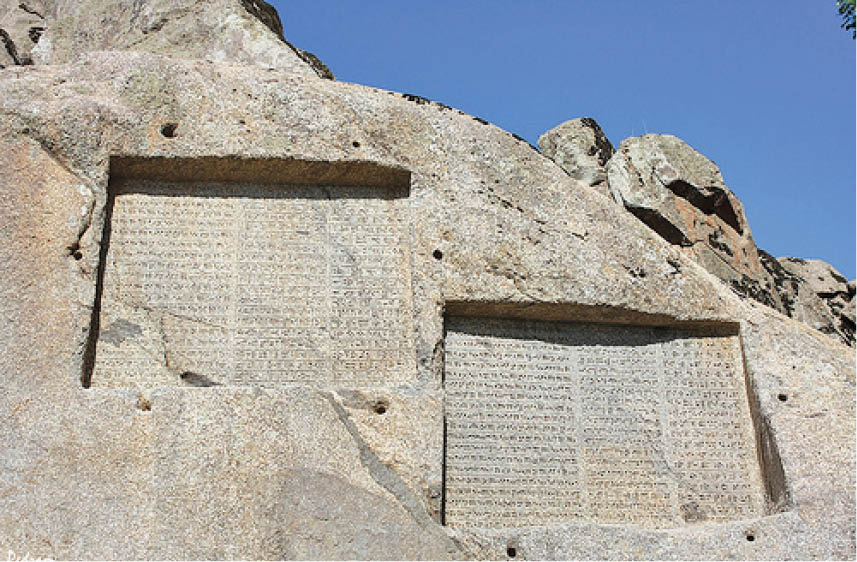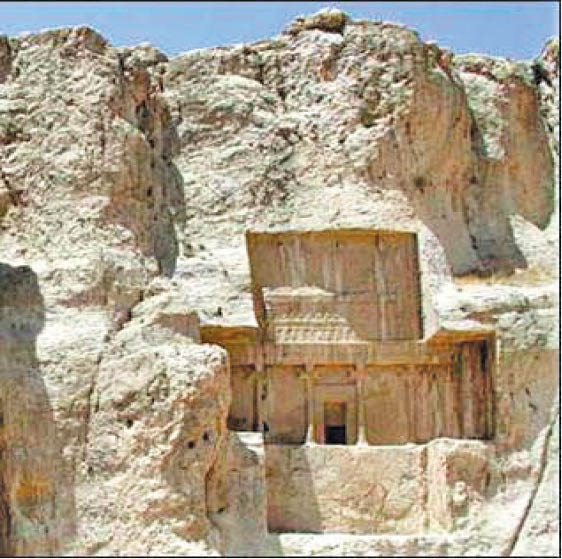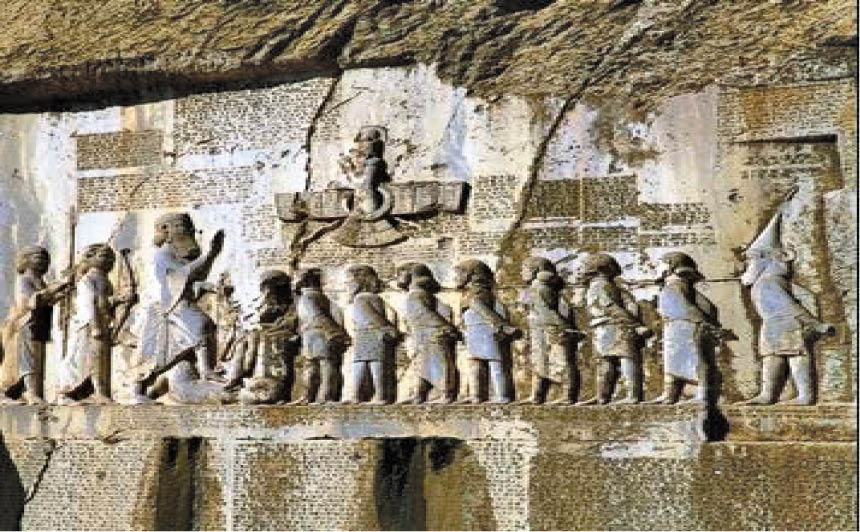.

Darius The Great – Part I
.
After the death of Cyrus the Great, his son, Cambyses, ascended the throne in 529 BC The latter conquered Cyprus and extended his sway right up to Abyssinia, Libya and the Greek settlement of Tripoli. Cambyses had no children and hence, after his death, there was chaos. The various conquered territories began to rise in rebellion and various imposters, the chief among them being Gaumata the Median, appeared on the scene to usurp the royal throne.
It was at this critical time in Persian history that Darius, the son of Hystaspe and scion of the royal family, took charge of the administration in 521 BC. After fighting nineteen battles and capturing nine pretenders to the throne, “by the Grace of Ahura Mazda”, as Darius put it, he firmly established his supremacy over all the conquered nations.
First World Empire

Darius’ empire stretched from the river Danube (Europe) in the west, right up to Sind and the present-day Frontier Province and part of the Punjab and from Central Asia right up to the north-eastern parts of Africa. For its time, it was a bold and innovative feat.
For administrative purposes, the empire was divided into various satrapies, or a provincial government, who’s Satraps or governors were appointed by the King himself and were directly responsible to him for civil administration, justice, finance, law and order. The provinces enjoyed a great deal of independence in local matters, but had to pay tribute regularly and provide recruits for the great King’s army.
Darius was a visionary and able statesman. In the footsteps of Cyrus, he helped the Jews complete the task of building the Temple of Solomon, as a result of which even Darius is fondly remembered in the Jewish books of Ezra, Haggai and Zechariah. Darius was not just a conqueror, but also an empire-builder. He built roads, bridges and waterways to reach far-flung parts of his empire. The royal highway from Susa to Sardis was about 1700 miles along with 107 post-houses and fine caravansaries.
Darius is credited with pioneering the world’s first postal service. He was also the first to build the prototype to the Suez Canal connecting the Red Sea with the Mediterranean.

Postal Service
“Neither snow, nor rain, nor heat, nor gloom of night stays these courageous couriers from the swift completion of their appointed rounds” was said about 2500 years ago by the Greek historian, Herodotus. He said this maxim during the war between the Greeks and Persians in about 500 B.C. in reference to the Persian mounted postal couriers whom he observed and held in high esteem.
Today many people believe this saying to be the U.S. Postal Service (USPS) motto. The reason it has become identified with the USPS is because in 1896-97, when New York City’s General Post Office was being designed, Mitchell Kendal from the hired architectural firm, came up with the idea of engraving Herodotus’ words around the outside of the building. Then on, the saying has been associated with US postal carriers. But, in truth this is a tribute to Darius the Great and the Achaemenians who pioneered a postal system five centuries before the birth of Christ!
Contribution To Law
Australian archaeologist and lecturer in biblical archaeology and pre-classical antiquity at the University of Melbourne, William Culican in his work the ‘Medes & Persians’ remarks that the “Laws of the Medes and Persians” became a by-word of judicial incorruptibility and harshness, throughout the subject lands. Execution by crucifixion is a Persian invention. It was the Zoroastrians who gave the world legal principles enshrined in the law of evidence and procedure. Legal concepts like arbitration, release on bail and representation by a lawyer, power of attorney and execution of wills are of Persian origin, later picked up by the Greeks and Romans. Few may know that in recognition of Zoroastrian contribution to the development of law, a statue of Zoroaster (Zarathushtra) stands in the Court of the Appellate Division (near Madison Square and 23rd Street New York City) with other great law givers.
Inscription At Mount Behistun
At Behistun (or Bisutun) one can see one of the most famous inscriptions of Darius the Great. In the rock relief, Darius is seen with his left hand on a bow. Behind him stands his Vazir and before him, ten kings, including Guamata (the pretender to the throne) with hands bound behind them and chains around their necks. The inscriptions provide a graphic description of the outstanding events of Darius’ reign. There were deciphered by Sir Henry C. Rawlinson in 1841 and helped resolve many historical obscurities.
At Behistun, Darius enumerates the tributary countries, which owe him allegiance:
“Thus says Darius the King: These are the countries, which came unto me, by the Grace of Ahura Mazda. I became King of them: Persia, Susiana, Babylonia, Assyria, Arabia, Egypt, the (lands) on the sea, Sparda, Ionia, Media, Armenia, Cappadocia, Parthia, Drangiana, Aria, Chorasmia, Bactria, Soghdiana, Gandara, Scythia, Sattagydia, Arachosia and Maka; twenty-three countries in all.
“Thus says Darius the King: These are the countries which came unto me, by the Grace of Ahura Mazda, they became subject unto me, they brought tribute unto me, whatsoever commands I gave them by night or day, these they performed.”
To convince readers of the authenticity of his inscriptions, Darius states:
“That which I have done I have always done by the Grace of Ahura Mazda. Thou who shalt hereafter read this inscription, let that which is done by me appear true unto thee; regard it not to be a lie.”
“Thus says Darius the King: Let Ahura Mazda be witness that it is true and not false, all this have I done.”
“Thus says Darius the King: By the Grace of Ahura Mazda, there is much more done by me, which is not written in this inscription; for this reason it is not written, lest he who shall hereafter read this inscription, to him that which has been done by me should seem exaggerated, it may not appear true to him, but may seem to be false.”
Later, once again, Darius devotedly ascribes all his achievements to the Divine help he received:
“That which I have done, I have done with the Grace of Ahura Mazda. Ahura Mazda brought me help….. For this reason Ahura Mazda brought me help, because I was not wicked, nor a liar, nor a tyrant, neither I nor my family.”
- The Feast Of Tirgan - 23 November2024
- Life And Message Of Asho Zarathushtra – II - 16 November2024
- Life And Message Of Asho Zarathushtra –I - 9 November2024

Whilst talking of Great Zoroastrian Kings, we must try and perceive the matter with circumstances too.
For example at times the circumstances are more difficult yet the leaders performed well and at times though performing well , lose out too.
It has been noticed that when Zoroastrians talk of our Empire , we either go to the Achmenid Period of Kourush (Cyrus) the Great, Darayus 1 and Xerxes,and then Jump straight to the Arab Invasion. We completely forget the era and reason for the Arabs being able to defeat the Zoroastrian Empire, which takes us to Pre Islamic, Byzantine thirst to convert Zoroastrian Persia into Christianity which led to a near 700 year war between the Zoroastrians and Byzantum though it was the Zoroastrians who gave early christians refuge in Persia duirng the end of Parthian Dynasty.
Unfortunately the Zoroastrians have forgotten this era where the Zoroastrian Kings had to fight to keep strategies of Byzantum to divide the Zoroastrians , Invade Persian lands and convert Zoroastrians into Christianity,whereby Armenia was the first to fall to the conversions and break away from Zoroastrianism. A lot of Zoroastrian Kings like Piroz who even gave land from Zoroastrian Persia to the byantines to profess their faith were only back stabbed when the Byzantines regrouped to once attack Zoroastrian strongholds. Another ploy as Done by Maurice on being defeated was to give the Byzantum noble women in hand to Zoroastrian Monarchy to then make the offspring revolt against the Zoroastrian Father and Empire.
It is no coincidence that Mazdakism, Mancheism suddenly sprung up during these era dividing the Zoroastrians just like spring revolutions crop up out of nowhere in Modern world. The Byzantines screamed ‘Intolerance”, labeling likes of Mubed Maresand Adurbad and Kartir and Even Kings Like Kushro 2 as “Anti God” just because they protected the Zoroastrian Faith and people from being converted by Missionaries.
An interesting fact of Mubed Kartir is the propoganda attached with him. Yes, he did re convert Zoroastrians converting out and broke Idols from Zoroastrian homes that had gone astray,but he also gave land for other faiths to practise their own faith. Whilst the former is propagated to show Kartir in bad light, the latter part is purposely omitted to show that there was no tolerance in Sasanid Persia. Once Zoroastrian lands were over come by the Byzantines by creating mischief and instigating people against their own Sasanian kings, Agiaries gave way to Churches as seen in Armenia where Vartaan Magmonian is known to boast of breaking “Heathen fire temples and worship of false Gods” to then be baptized into churches. The mishief created by the missonaries was the reason for Zoroastrian Kings having stricter rule.
To cut a long story short, Later on it was the Byzantines which held hands of the new Born religion of the Arabs to extinguish the Zoroastrian flame and they together gave the last push to our Empire. Once the Zoroastrians were made a minority, these two divided the conquered land , which could in a way be said to have the prelude to the crusades as then these two strated warring amongst themselves for power thru religion.
Thus, it was these Sasanian kings who faced the Greatest challenge and tirelessly worked to save Zoroastrianism from the Onslaught of those who wanted to convert Persia out of Zoroastrianism into Christianity an Islam.
The irony though is that whilst the Zoroastrian Flame continues to flicker on, both these two continue to fight in Persian lnds and elsewhere to quench their thirst to convert the World.
Thus whilst talking of Great Zoroastrians, It was Kings like Ardeshir Papakan, Shapur, Khusrow 2, Piroz, and The sasanian hierarchy that fought most to Preserve Zoroastrianism from enemy onslaught.
I foresee us Zoroastrians falling prey to the same strategy as History repeats unto those who forget it, when the same Strategy is repeated in India by those who want to retain power thru conversions